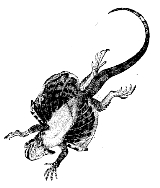
Draco lizard
Encyclopedia
Draco also known as Flying Dragons is a genus of agamid
lizard from South and Southeast Asia. The ribs and their connecting membrane can be extended to create a wing, the hindlimbs are flattened and wing-like in cross-section, and a small set of flaps on the neck serve as a horizontal stabilizer. Draco are arboreal insectivores. While not capable of powered flight they often obtain lift in the course of their gliding flights. Glides as long as 60m have been recorded, over which the animal loses only 10m in height, which is quite some distance, considering that one of these lizards is only around 20 cm long.
The only time a flying lizard ventures to the ground is when a female is ready to lay her eggs. She descends the tree she is on and makes a nest hole by forcing her head into the soil. She then lays 2-5 eggs before filling the hole. She guards the eggs for around 24 hours but then leaves and has nothing more to do with her offspring.
Linnaeus
derived the name of this genus from the Latin term for mythological dragon
s.
membranes supported by elongated thoracic ribs to generate lift forces.
Agamidae
Agamids, lizards of the family Agamidae, include more than 300 species in Africa, Asia, Australia, and a few in Southern Europe. Many species are commonly called dragons or dragon lizards. Phylogenetically they may be sister to the Iguanidae, and have a similar appearance. Agamids usually have...
lizard from South and Southeast Asia. The ribs and their connecting membrane can be extended to create a wing, the hindlimbs are flattened and wing-like in cross-section, and a small set of flaps on the neck serve as a horizontal stabilizer. Draco are arboreal insectivores. While not capable of powered flight they often obtain lift in the course of their gliding flights. Glides as long as 60m have been recorded, over which the animal loses only 10m in height, which is quite some distance, considering that one of these lizards is only around 20 cm long.
The only time a flying lizard ventures to the ground is when a female is ready to lay her eggs. She descends the tree she is on and makes a nest hole by forcing her head into the soil. She then lays 2-5 eggs before filling the hole. She guards the eggs for around 24 hours but then leaves and has nothing more to do with her offspring.
Linnaeus
Carolus Linnaeus
Carl Linnaeus , also known after his ennoblement as , was a Swedish botanist, physician, and zoologist, who laid the foundations for the modern scheme of binomial nomenclature. He is known as the father of modern taxonomy, and is also considered one of the fathers of modern ecology...
derived the name of this genus from the Latin term for mythological dragon
Dragon
A dragon is a legendary creature, typically with serpentine or reptilian traits, that feature in the myths of many cultures. There are two distinct cultural traditions of dragons: the European dragon, derived from European folk traditions and ultimately related to Greek and Middle Eastern...
s.
Classification of genus Draco
- Draco affinis
- Draco biaro
- Draco bimaculatus
- Draco blanfordiiDraco blanfordiiDraco blanfordii is an agamid "flying" lizard capable of gliding from tree to tree found in China , E Thailand, W Malaysia, Myanmar, Vietnam, India and Bangladesh....
- Draco caerulhians
- Draco cornutus
- Draco cristatellus
- Draco cyanopterus
- Draco dussumieriDraco dussumieriThe Southern Flying Lizard Draco dussumieri is an agamid lizard capable of gliding from tree to tree found in the Western Ghats and hill forests of southern India.-Description:...
- Draco fimbriatus
- Draco guentheri
- Draco haematopogon
- Draco indochinensisDraco indochinensisDraco indochinensis is an agamid flying lizard found in South-east Asia.-Description:It has earlier been considered synonymous to or a sub-species of Draco blanfordii. However, phylogenetic data and other supporting morphological features indicate that it is a separate species...
- Draco jareckii
- Draco lineatus
- Draco maculatusDraco maculatusDraco maculatus is an agamid flying lizard capable of gliding from tree to tree found in parts of Southeast Asia. It is commonly named the Spotted Flying Dragon.-Description:...
- Draco maximus
- Draco melanopogonDraco melanopogonDraco melanopogon is an agamid flying lizard found in South-east Asia.-External links:*...
- Draco mindanensis
- Draco norvilliiDraco norvilliiDraco norvillii is an agamid flying lizard, capable of gliding from tree to tree, which is found in India . The species have been recorded gliding up to 50 meters. A rare and endangered species of lizard named after the collector of the type Draco norvillii is an agamid flying lizard, capable of...
- Draco obscurus
- Draco ornatus
- Draco palawanensis
- Draco quadrasi
- Draco quinquefasciatus
- Draco reticulatus
- Draco rizali
- Draco spilopterus
- Draco sumatranusCommon Gliding LizardThe Common Gliding Lizard is a lizard with elongated ribs and skin flaps on the sides of its body. When opened, these skin flaps allow it to glide between tree trunks. It is primarily a tree dweller, except that the females come down to the forest floor to lay eggs. The body length is of about...
- Draco taeniopterus
- Draco volans
Gliding
The lizards are well-known for their 'display structures' and ability to glide long distances using their wing-like patagialPatagium
*In bats, the skin forming the surface of the wing. It is an extension of the skin of the abdomen that runs to the tip of each digit, uniting the forelimb with the body.*The patagium of a bat has four distinct parts:...
membranes supported by elongated thoracic ribs to generate lift forces.

